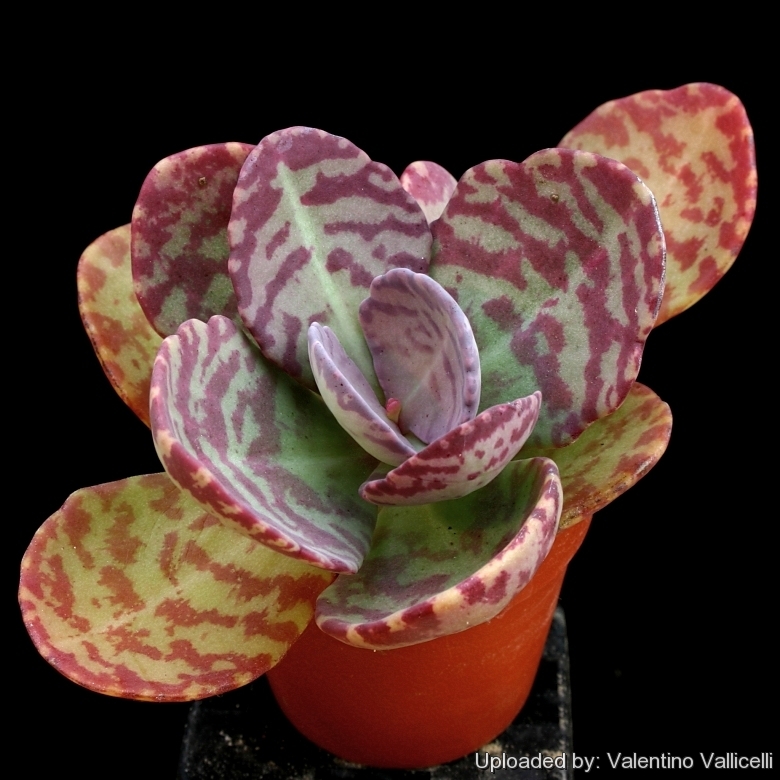
Kalanchoe humilis Photo by: Valentino Vallicelli
Origin and Habitat: Tanzania, Malawi (Mt. Mdima ), Mozambique ( Sérra de Ribáuè, Mepáluè and Ruo River.)
Altitude: 800-1400 m over sea level.
Habitat: Grows among rocks and in crevices sometime on rocky island in rivers falls and rapids.
Synonyms:
See all synonyms of Kalanchoe humilis
back
Accepted name in llifle Database:Kalanchoe humilis BrittenFl. Trop. Afr. [Oliver et al.] 2: 397. 1871Synonymy: 3
Cultivars
(1):
back
Common Names include:
ENGLISH: Spotted Kalanchoe, Penwiper, Penwiper Plant, Baby Penwiper, Stipped Kalanchoe
Description: Kalanchoe humilisSN|21420]]SN|21420]] is a low growing perennial succulent with very decorative leaves strongly marked with burgundy stripes. It forms a small shrub 30-90 cm tall (with the inflorescence)
Rosettes: Open with leaves crowded at stem apexes the lower spreading, the upper suberect.
Stem: 2-10 cm long (up to 20 cm in cultivation) arising from a woody base up to 1 cm thick, unbranched or with few branches, purple or slightly glaucous.
Leaves: Subsessile, about 3-13 cm, long, 2-6 cm wide, completely glabrous, grey-green with a slight glaucous bloom on both sides, strongly marked with maroon spots and stripes, decussate, fleshy, rigid, obovate often subtruncate at the top margins entire or sometime obtusely crenate towards the apex, cuneate below. The leaves are soon lost from the lower parts of the plant.
Inflorescence: Erect, branched panicle 12-38 cm tall from the centre of the rosette, very ample, very floriferous and with flexuous axis, with a glaucous bloom.
Flowers: Small, erect or horizontal, dull purple to green, not particularly decorative.
Blooming season: Mid-summer.
Subspecies, varieties, forms and cultivars of plants belonging to the Kalanchoe humilis group
 Kalanchoe humilis Britten: is a low growing perennial succulent with very decorative leaves strongly marked with burgundy stripes. Distributio: Tanzania, Malawi and Mozambique.
Kalanchoe humilis Britten: is a low growing perennial succulent with very decorative leaves strongly marked with burgundy stripes. Distributio: Tanzania, Malawi and Mozambique. Kalanchoe humilis cv. Desert Surprise Britten: is a selected clone of Kalanchoë humilis with paddle shaped blue-green leaves with spectacular purple markings.
Kalanchoe humilis cv. Desert Surprise Britten: is a selected clone of Kalanchoë humilis with paddle shaped blue-green leaves with spectacular purple markings.
Bibliography: Major references and further lectutures
1) Flora Zambesiaca - volume:7 part:1 (1983) Crassulaceae by R. Fernandes
Cultivation and Propagation: Kalanchoe humilisSN|21420]]SN|21420]] is very easy to grow and drought-resistant, it makes an interesting plant in any collection and is rewarding. It is also easy to take care as indoor plant.
Potting mix: It thrives in nutrient poor soils consisting of equal parts of loam and sand, with pumice or lava grit added to ensure good drainage.
Exposure: It takes a good deal of sun, though still prefers some shade.
Watering: It needs moderate watering in autumn and spring while in summer it should be watered thoroughly and allowed to dry before watering again. In winter give only occasional watering (only when the plant starts shrivelling), but it will generally grow even in winter if given water. These plants will survive on neglect. Over-watering is the most common cause of plant failure.
Frost resistance: It prefers intermediate to warm temperatures but it is hardy to -2 ° C for short periods.
Maintenance: The flowers are not much of an attraction and can be removed.
Propagation: It is propagated by removal of small offsets at the base of the main plant or by leaf and stem cuttings. It grows easily roots at the end of a leaf stalk which has fallen onto ground. New plants are ready within months.
Use: It is an ideal plant for containers or rock gardens.










